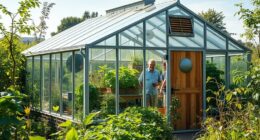Growing your own food in a greenhouse helps you enjoy fresh, healthy produce year-round while reducing your environmental footprint. By using small spaces like containers or raised beds, you can cultivate vegetables and herbs sustainably without long-distance transportation. Composting food scraps turns waste into valuable nutrients, supporting healthy plants. This approach empowers you to control what you eat and minimize chemical use. Keep exploring to find out how to maximize your greenhouse’s potential for a more sustainable lifestyle.
Key Takeaways
- Using a greenhouse extends growing seasons, allowing year-round cultivation of fresh vegetables and herbs for sustainable eating.
- Greenhouses provide controlled environments, reducing the need for chemical pesticides and promoting organic, chemical-free produce.
- Incorporating composting in your gardening routine enriches soil naturally, supporting healthy plant growth and waste reduction.
- Container gardening within greenhouses maximizes space efficiency and simplifies pest management, ensuring higher yields.
- Growing your own food fosters ecological responsibility, minimizes carbon footprint, and enhances food security for a sustainable lifestyle.

Growing your own food is a powerful step toward promoting sustainability and reducing your environmental impact. When you embrace urban gardening, you turn small spaces into productive plots, making the most of limited land in city environments. Urban gardening doesn’t require vast farmland; even balconies, rooftops, and window sills can become thriving vegetable and herb gardens. By cultivating your own produce, you cut down on the carbon footprint associated with store-bought items that often travel long distances. Plus, growing your own food gives you control over how it’s grown, minimizing the use of harmful chemicals and pesticides.
Getting started with urban gardening is straightforward, but understanding composting basics can amplify your efforts. Composting turns kitchen scraps and yard waste into nutrient-rich soil, which is essential for healthy plant growth. Instead of tossing vegetable peels, coffee grounds, or eggshells into the trash, you add them to your compost bin. Over time, these materials decompose into dark, crumbly compost that naturally feeds your plants. This process not only reduces waste sent to landfills but also boosts your garden’s productivity without relying on synthetic fertilizers. Composting basics involve maintaining the right balance of “greens” (like fruit and vegetable scraps, coffee grounds) and “browns” (such as dried leaves, paper, or straw). Keep your compost moist, turn it regularly to aerate, and avoid adding meat or dairy to prevent odors and pests. As you master composting basics, you’ll notice your garden flourishing with less effort and expense.
Your urban gardening journey can be further enhanced by using containers or raised beds, which help manage soil quality and control pests more effectively. Growing your own food inside a greenhouse or in a sunny windowsill allows you to extend your growing season and protect delicate plants from harsh weather. This controlled environment encourages faster growth and higher yields, making it easier to enjoy fresh vegetables and herbs year-round. When you combine urban gardening with composting basics, you create a sustainable cycle: waste becomes nourishment, and your garden produces food that sustains you and the planet.
Incorporating these practices into your lifestyle not only reduces your reliance on industrial agriculture but also fosters a deeper connection to the food you eat. It empowers you to take responsibility for your environmental footprint while enjoying the satisfaction of harvesting your own fresh produce. Growing your own food through urban gardening and composting basics makes sustainability accessible, practical, and rewarding—turning your space into a source of nourishment and ecological harmony.
Frequently Asked Questions
What Are the Most Cost-Effective Crops for Beginners?
If you’re starting out, focus on beginner-friendly crops that are also cost-effective vegetables. Lettuce, radishes, and green beans are great choices because they grow quickly and require minimal space and resources. Carrots and herbs like basil or cilantro are also affordable and easy to cultivate. These crops help you save money while giving you a satisfying gardening experience, making them perfect for beginners looking to grow their own food.
How Can I Extend the Growing Season in My Greenhouse?
Imagine your greenhouse as a cozy sanctuary, sheltering plants from harsh weather. To extend your growing season, you can use season extension techniques like adding insulation, row covers, or thermal curtains. Combining these with greenhouse climate control—like heaters or fans—creates a stable environment year-round. This way, your plants thrive longer, and your garden stays bountiful through changing seasons.
What Pests Are Common in Home-Grown Vegetables?
You’ll likely face pests like aphids, caterpillars, and whiteflies in your home-grown vegetables. To keep them at bay, use pest prevention strategies like crop rotation and encouraging beneficial insects. Opt for natural pest control methods such as introducing ladybugs or neem oil, which are eco-friendly and effective. Regularly inspect your plants, and act quickly to prevent pests from damaging your harvest.
How Do I Compost Efficiently in a Small Space?
Did you know small spaces can compost effectively? To do so, place your compost bin in a shady, well-drained spot to speed up decomposition and reduce odors. Use kitchen scraps and yard waste, turning your organic waste reduction efforts into rich compost. Keep it moist and aerate regularly. Even in tight spaces, consistent effort turns scraps into black gold for your garden, making waste work for you.
What Are Eco-Friendly Ways to Water My Garden?
You can water your garden eco-friendly by using rainwater harvesting systems, capturing rain to reduce reliance on tap water. Additionally, install drip irrigation to deliver water directly to plant roots, minimizing runoff and evaporation. These methods conserve water and promote sustainability. By combining rainwater harvesting with drip irrigation, you guarantee your garden stays healthy while reducing your environmental impact effectively.
Conclusion
So, after all that effort, you might find it amusing how growing your own food actually saves the planet—one tomato at a time. Ironically, the more you invest in your greenhouse, the less you rely on big agriculture and its environmental toll. Turns out, the simplest act of planting and tending can be your most sustainable move. Who knew that your backyard could become the ultimate eco-friendly revolution? Now, go ahead, enjoy your homegrown feast—nature’s little irony.









